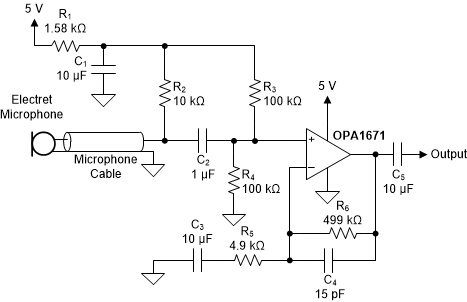JAJSGG7B January 2019 – August 2019 OPA1671
PRODUCTION DATA.
- 1 特長
- 2 アプリケーション
- 3 概要
- 4 改訂履歴
- 5 Pin Configuration and Functions
- 6 Specifications
- 7 Detailed Description
- 8 Application and Implementation
- 9 Power Supply Recommendations
- 10Layout
- 11デバイスおよびドキュメントのサポート
- 12メカニカル、パッケージ、および注文情報
パッケージ・オプション
メカニカル・データ(パッケージ|ピン)
サーマルパッド・メカニカル・データ
発注情報
8.2 Typical Application
This design uses an OPA1671 as a preamplifier for an electret microphone. Electret microphone types are common in many audio applications of varying performance levels. The OPA1671 offers very low noise in a tiny package, and is designed for use in electret preamplifier circuits.
Figure 34 shows the solution.
 Figure 34. Electret Preamplifier Schematic
Figure 34. Electret Preamplifier Schematic